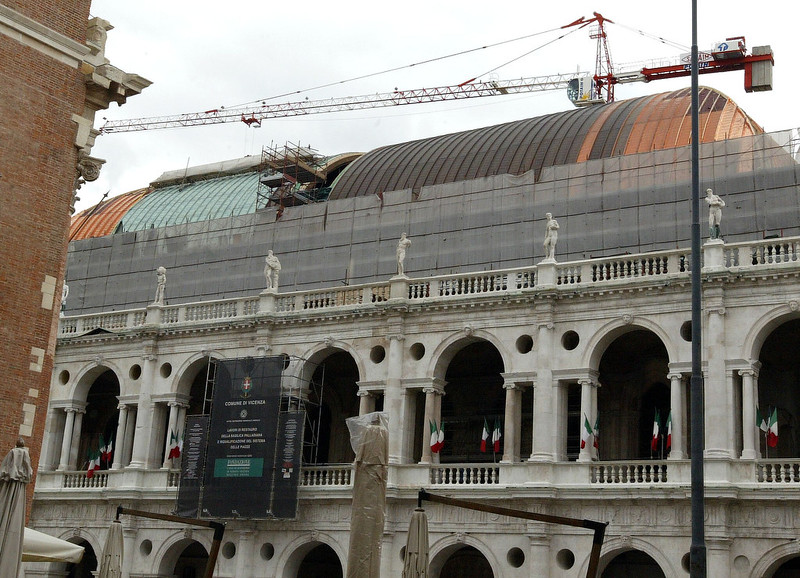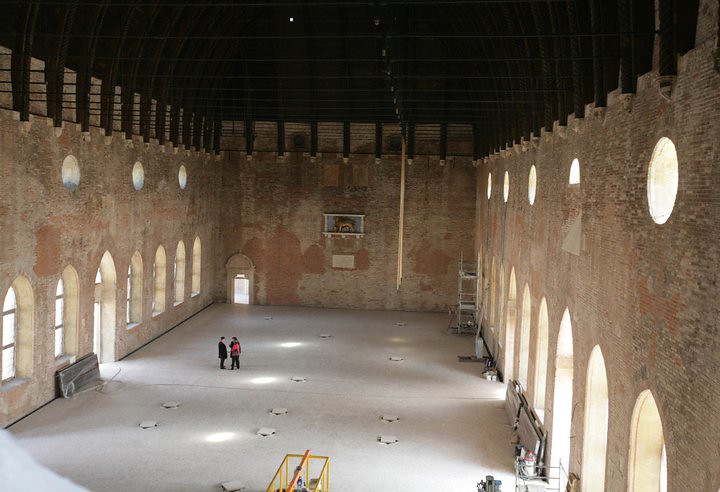Restoration

Between 2007 and 2012, the Basilica Palladiana underwent a complex and comprehensive architectural, functional, and system restoration project, thanks to the fundamental contribution of Fondazione Cassa di Risparmio di Verona Vicenza Belluno e Ancona.
The project and restoration work were structured on three fronts to preserve the monument's extraordinary figurative and spatial qualities and ensure its functionality with system upgrades suited to its new uses, particularly large cultural events capable of attracting a large audience:
-
- Interventions dedicated to interior and exterior decorative elements: cleaning, consolidation, and protection of materials;
-
- Equipment services, with the use of existing passageways, differences in level, and pavement subfloors for the installation of new systems;
-
- Restoration of the large roof, shaped like an upturned ship's hull, destroyed by a bomb during World War II and later rebuilt with reinforced concrete arched structural elements. The project saved the copper cladding and most of the wooden paneling, and replaced the large concrete arches with laminated wood, better suited to withstanding seismic vibrations.

The restoration project was developed between 2004 and 2006 by a group of designers who won a European competition launched by the City of Vicenza in February 2002. The competition required combining conservation and enhancement, ensuring safety and environmental well-being to allow not only a full tour of the Basilica Palladiana, but also a use appropriate to the building's historical and monumental value.
The restoration was coordinated by architect Eugenio Vassallo, who oversaw the design and construction management, and was carried out by the Sacaim company.

Today, the entire monumental complex, and the exhibition and reception spaces, are suitable for hosting major exhibitions; the first-floor hall can host important events while ensuring environmental well-being and safety; access to the panoramic terrace on the second floor is guaranteed for a large audience; the entire monument can be visited and explored in its entirety, including by persons with disabilities.
Upon work completion, the Basilica Palladiana was returned to the city and the world as a cultural center capable of hosting international events and as a focal point for citizens. The revitalization of the ground-floor shops and restaurants significantly impacted the overall urban planning.
European Union Award for Cultural Heritage - Europa Nostra Competition 2014
The restoration of the Basilica Palladiana was awarded the “European Union Award for Cultural Heritage - Europa Nostra Competition 2014” for cultural heritage conservation. The Basilica was selected among 26 projects, chosen from nearly 200 submissions from thirty countries in four categories: conservation, research, exemplary contributions, and education-training-awareness. In addition to celebrating outstanding work in the protection of cultural heritage, this prestigious award promotes high standards and expertise in conservation.
The award ceremony was held on May 5, 2014, at the Burgtheater in Vienna under the auspices of Austrian President Heinz Fischer, in the presence of Androulla Vassiliou, European Commissioner for Education, Culture, Youth and Multilingualism, and Plácido Domingo, opera singer and President of Europa Nostra.
Award Citations
The Basilica Palladiana in Vicenza is one of the most important urban projects by Andrea Palladio (1508-1580), an extraordinarily influential Italian architect. Not only is it an iconic monument, but it is also used for public events and is frequently visited by tourists, thus putting it to the test. The project's objectives were to clean, reinforce, and protect the interior and exterior decorations; and to install a new network of utilities within the existing passageways and attics. However, the most significant intervention was to correct the damage caused 60 years ago by the use of reinforced concrete to repair the roof, destroyed by a bomb. Furthermore, several surrounding buildings were transformed and now house some of the Basilica's service functions, such as offices, plant control centers, and logistics services.
Today, the Basilica Palladiana has returned to the prominent role it once held as Vicenza's most important historic building. The Jury is pleased to recognize the significant restoration work of a famous building, carried out professionally and meticulously, in contrast to the ill-fated restoration attempt that had caused serious damage to the structure in the past. In the mid-20th century, when the characteristics of the many new materials were still largely unknown, Palladio's principal public building, as well as a monument of primary importance, was subjected to inappropriate use of concrete to secure the roof. This error, combined with air pollution that had damaged the stone cladding of the façade, required significant, high-quality conservation work.

